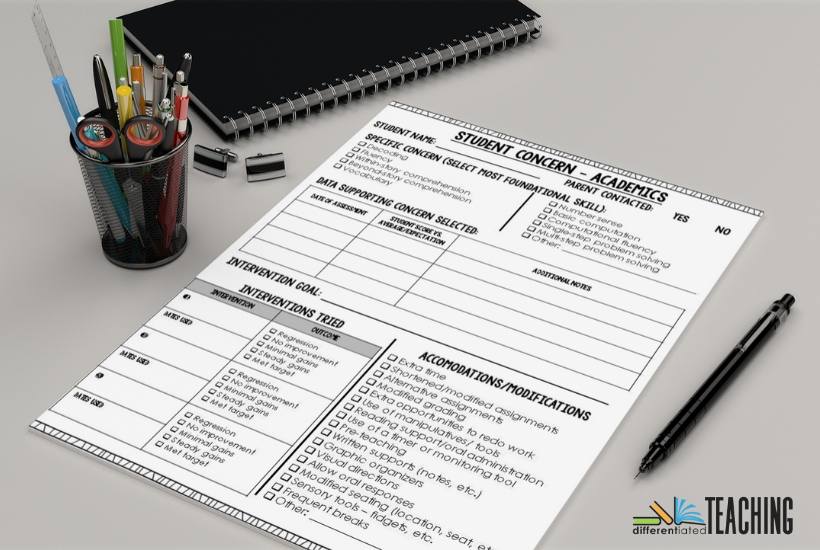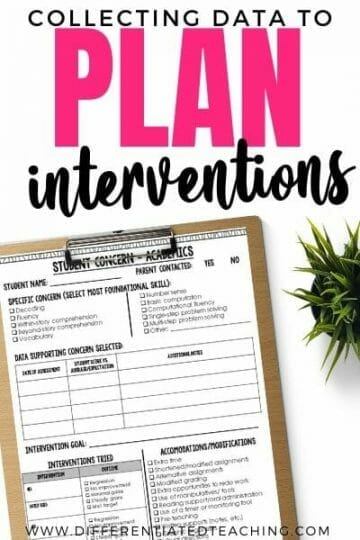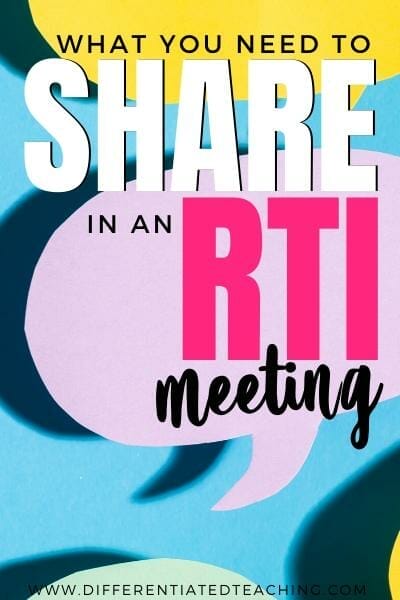Take control & get more done in your next RTI meeting
Whether your campus calls it a student support meeting, child study meeting, or something completely different, getting ready to meet with your campus RTI team can be a stressful and frustrating process when you’re the classroom teacher.

Here’s exactly what you need to prepare BEFORE your next RTI or MTSS meeting
The requirements for data and documentation can seem overwhelming, but it doesn’t have to be that way. Here are six essential things that will help you take control and get more out of your next RTI meeting (and a great free organizer to help you get it all together).
1. Identify your specific area of concern
I sit in many SST meetings as a part of my role as a coach for RTI. I cannot tell you how many times I’ve heard that little Joey is struggling with reading.
Reading is HUGE! It is impossible for a team to plan an effective intervention if the only information they have is that Joey struggles with reading.
Your student will be guaranteed a much more appropriate intervention and you’ll earn some major credibility as an authority on your students if you can bring a specific area of concern to the table.
For example, Joey might struggle to comprehend because he isn’t fluent…and he might not be fluent because he is making a ton of errors when he reads. In that case, the area of concern you would want to bring to the team is accuracy because it is the foundational skill that, if intervened on, should improve all the others mentioned automatically.
Alternatively, maybe Joey is great at reading the words accurately, but he is SOOO SLOW. In this scenario, an intervention planned to improve accuracy would be a waste of Joey’s time.
The more specific information you can bring about the concern you have, the more likely you are to match your student with the right intervention the first time and to see the progress that you are all aiming for.
2. Collect and organize recent data
Never walk into a meeting bringing data more than 2-3 weeks old. Really, just don’t do it!
Too many teachers (and teams) relying on data from the beginning of the school year when it’s the middle of winter. This is not in anyone’s best interest, especially the student. Plus, it gives the impression that you haven’t been closely monitoring the student in class.
When you know a student’s meeting is coming up, build 10-15 minutes into your schedule to collect current data.
Be sure to focus your data collection on the specific concern you are meeting about. If it is reading, consider taking a running record or gathering quick one-minute fluency data that can also serve to evaluate accuracy.

If math is the concern, have the student complete a short 3-5 minute timed fact sheet if the concern is computation. You can also bring work samples you have from your class that shows the specific concern.
Even behavior concerns should have numerical data associated with them. Keep a post-it note and tally the number of reminders a student gets to stay in their seat…or track the number of times they blurt out.
This data will be invaluable when selecting the best intervention for your student.
3. What you’ve been doing – classroom interventions
Before a student is referred for problem-solving, the expectation at most schools is the classroom teacher has made significant attempts to provide the student with additional support and intervention.
Be sure to bring documentation (or at least a list) of the specific strategies you’ve used to address the need you identified. You’ll also want some data on how each one worked. This might be observational data or analysis of classwork. It should be something objective and more than just “the student is having a hard time and is behind”.

The more concrete the data is the easier it will be for the team to see the concern that should be addressed. It is also more likely the team will take action due to the student’s lack of response to your efforts.
You’ll also want some data on how each intervention worked. This might be observational data or analysis of classwork, but it should be something objective and more than just that the student is having a hard time and is behind.
Similarly, the more concrete the data is, the easier it will be for your school’s SST team to clearly see the concern that should be addressed and the more likely the team is to take action based on the student’s lack of response to your efforts.
4. What you’ve been doing – accommodations & modifications
Many teachers remember to bring this information in, but they present it as the intervention instead of how they are modifying to allow the student to access the curriculum and show their knowledge. Accommodations and modifications include things like:

A checklist is another common accommodation.
- preferential seating
- shortened assignments
- use of manipulatives
- tests or assignments read aloud
- use of a timer
These aren’t necessarily focused on your specific area of concern. Instead, they cover how you adjusting instruction and practice to meet the student where they are and allow the greatest access to the learning.
5. Background Information
This one is a sticky one because it can (and does) lead to gossip in many cases. However, extremely relevant to the planning and intervention process is often skipped over. For example, a student who always forgets her glasses or is dealing with a recent divorce might need more than just a reading intervention.
A student who always comes late might be struggling because he misses the first 15 minutes of math class. Bringing relevant background information to the meeting to inform intervention planning, without sidetracking the conversation toward gossip, is critical.
Relevant background information helps you make the most of your SST planning and allows the team to make the best-informed decisions possible.
6. A realistic goal for the meeting & openness to an honest conversation
Sometimes the SST team creates a plan that involves another attempt at intervention by you in the classroom. This doesn’t mean they don’t feel you’ve done enough or that you aren’t doing a great job.
Many times this happens because they trust that you have the best relationship with the student. This makes you the person most likely to be able to make the change with a few new tools in your toolbelt.
It can be frustrating to leave an SST meeting with more on your plate. This is where the open, honest conversation comes in. Don’t be afraid to speak up if you feel ill-equipped to implement the intervention. Tell them you are nervous about taking on one more thing.

When the team knows your concerns, they can work to develop a plan to support you – whether it be through modeling, checking in with you, helping create resources or tools, or words of encouragement.
It doesn’t have to be so hard!
Taking a student to your SST team can feel like an uphill battle.
Approach the process with honesty.
Come prepared with the key information. With those things, you’ll know that you’re doing your best to support your struggling student.
To help you, I’ve created this simple organizer to make it easy to walk into your meeting prepared. Enter your info to get it delivered to your email for free!






